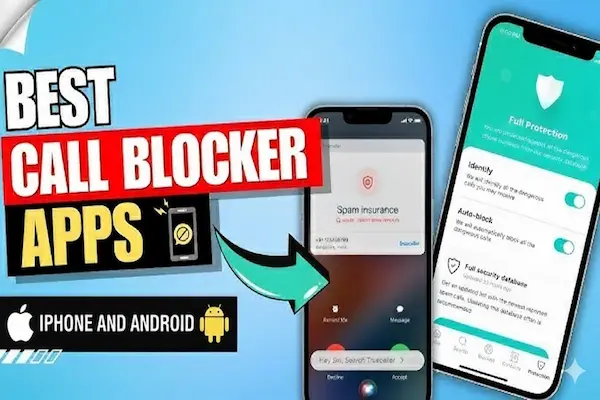Protect Your Phone from Unwanted Calls and Messages
Learn how protect your phone with the spam blocker app!
Advertising
Discover the best apps and how to stay safe while keeping your smartphone free from spam.
What Is a Spam Blocker App
A Spam Blocker App is a mobile application designed to detect, filter, and block unwanted calls and messages before they reach you.
Think of it as a smart security guard standing between your phone number and the outside world.
When someone calls you, the app quickly checks if that number is suspicious, reported as spam, or associated with known fraud patterns.
If the number looks risky, the app can silently block or label the call so you know it is not worth answering.
For text messages, the app can analyze sender information, text content, and even links to identify possible phishing or scam attempts.
Suspicious messages can be moved to a separate spam folder, flagged with a warning, or blocked completely.
In practice, a Spam Blocker App helps you see more of what matters and far less of what does not.

Why Spam Calls and Messages Are So Dangerous
Spam is not just “annoying advertising”.
Behind many of those calls and messages are organized scams.
They may try to steal login details, credit card numbers, or other sensitive data.
Some scammers pretend to be your bank, a delivery company, a tech support agent, or even a government agency.
They often use urgency, fear, or fake rewards to push you into making quick decisions.
One distracted moment is enough to click a malicious link or share private information you later regret.
Older adults, children, and busy professionals are especially vulnerable, but anyone can be tricked.
By using a Spam Blocker App, you reduce how often you are exposed to these threats.
You still need to stay alert, but the number of dangerous interactions decreases significantly.
How a Spam Blocker App Works Behind the Scenes
A Spam Blocker App may look simple on the surface, but it uses several smart mechanisms to protect you.
Global spam and scam databases
Many apps rely on large databases of known spam numbers.
These lists are built using user reports, call statistics, and, in some cases, partnerships with carriers and security companies.
When enough people report a number as spam, it can be flagged for everyone using that system.
So if someone calls you from a number that has already been reported by many users, the app can immediately mark it as spam or block it.
Real-time analysis of calls
When an unknown number calls, the app quickly analyzes it in real time.
It may check patterns like how often the number calls people, how many times it has been rejected, and whether it appears in any spam lists.
Based on this, the app can show labels like “Spam risk”, “Telemarketer”, or “Scam suspected”.
You get more context, and you can decide calmly if you want to answer or ignore.
Smart filters for SMS and messages
For messages, a Spam Blocker App can scan the text looking for suspicious keywords, strange formatting, and unsafe links.
For example, messages that talk about fake prizes, urgent payments, or account “verification” are often red flags.
Suspicious messages can be automatically moved away from your main inbox, so you do not tap them by accident.
You stay in control, but the most obvious traps are filtered out.
Artificial intelligence and machine learning
Many modern spam blocker apps use artificial intelligence and machine learning.
These technologies allow the app to learn from millions of calls and messages, improving over time.
Every time users report a scam or confirm that a number is legitimate, the system gets a little smarter.
That means the longer you use a Spam Blocker App, the better it may become at protecting you.
The 5 best spam blocker apps
There are many options available, and the “best” one for you will depend on your needs, your region, and your device.
Below, you will find an overview of five widely known and popular apps that are often used as a Spam Blocker App solution.
We are not affiliated with any of them, and this list is for informational purposes only.
Always check details, features, prices, and reviews directly in your phone’s official app store before installing anything.
1. Truecaller
Download on iOS: Truecaller – App Store
Download on Android: Truecaller – Google Play
Truecaller is one of the most recognized names in call identification and spam blocking.
It uses a huge global database to identify callers and label potential spam.
Even if a number is not saved in your contacts, Truecaller may show you the name or type of caller.
The app can automatically block many known spam numbers and warn you about suspicious calls.
It also offers SMS filtering, separating suspected spam texts from your main inbox.
Truecaller has a free version with essential features and paid plans that add advanced caller ID and more control.
For users who receive calls from many different numbers and countries, its large database can be a strong advantage.
2. Hiya
Download on iOS: Hiya – App Store
Download on Android: Hiya – Google Play
Hiya is another popular Spam Blocker App that combines caller ID with robust spam detection.
It analyzes incoming calls and flags those that are likely robocalls, telemarketers, or scammers.
Hiya regularly updates its spam lists, which is vital since scammers frequently change numbers.
On some devices and with some carriers, Hiya technology is integrated into the phone’s native call system.
The app is designed to be easy to use, with a clean interface and clear alerts.
Many users appreciate its straightforward style and focus on call safety.
3. RoboKiller
Download on iOS: RoboKiller – App Store
Download on Android: RoboKiller – Google Play
RoboKiller is famous for aggressively targeting robocalls.
Beyond simple blocking, it uses advanced technology to identify spam calls based on patterns and audio signatures.
One of its most unique features is the use of “answer bots”.
These are prerecorded messages that answer spam calls and waste the scammer’s time.
This can reduce how often they try your number in the future.
RoboKiller also offers SMS filtering and detailed stats showing how many calls and messages were blocked.
For people constantly bothered by robocalls, this app can feel like turning down the volume on a very loud world.
4. Call Control
Download on iOS: Call Control – App Store
Download on Android: Call Control – Google Play
Call Control focuses heavily on community-powered blocking.
It uses reports from millions of users to identify and stop spam calls.
The app automatically blocks many known spam and robocall numbers.
One of its strengths is customization.
You can create your own personal blocklist and allowlist, giving you very specific control over who can reach you.
Call Control also lets you schedule “do not disturb” times for unknown callers, which is perfect for nights or important moments.
In some regions, it can filter SMS as well, helping to keep your text inbox cleaner.
5. YouMail
Download on iOS: YouMail – App Store
Download on Android: YouMail – Google Play
YouMail acts as both a Spam Blocker App and an upgraded voicemail service.
It can automatically block many spam and robocalls, often playing a “number disconnected” style message to discourage future attempts.
At the same time, YouMail provides visual voicemail features.
You can see and manage your voicemail messages in a more organized way.
The app also has options designed for professionals and small businesses, such as custom greetings.
If you want spam protection plus smarter voicemail in a single package, YouMail is a strong candidate.
Built-in protections vs using a dedicated Spam Blocker App
Most modern smartphones already include basic call and SMS blocking features.
You can usually block specific numbers and sometimes send unknown callers straight to voicemail.
On many devices, the system can show a generic “spam” label for some calls.
These tools are helpful, but they have limitations.
They may not have access to large, frequently updated global databases.
And they often offer less control than a dedicated app.
A Spam Blocker App usually adds more layers of intelligence, such as advanced caller ID, detailed spam categories, community-driven reports, and better SMS filtering.
The ideal setup for many people is to activate both native protections and a trusted spam blocker app.
Together, they create a stronger barrier against unwanted communication.
How to Choose the Right Spam Blocker App for You
There is no single perfect Spam Blocker App that fits everyone.
The best option depends on how you use your phone and what bothers you the most.
Here are some points to consider when deciding.
Think about how many spam calls and messages you receive each day.
If SMS spam is a big problem, pick an app with strong message filtering, not just call blocking.
If you often receive legitimate calls from unknown numbers, like clients, patients, or delivery drivers, you might prefer a more flexible app instead of one that blocks every unknown caller.
Check whether you want extra features such as answer bots, enhanced voicemail, business tools, or detailed reports.
Compare free and paid plans and see what you truly need before subscribing.
Finally, read recent reviews and ratings in your app store to understand how the app is performing today.
Apps evolve, and up-to-date feedback from real users is very valuable.
Step-by-Step: Setting Up Your Spam Blocker App
Once you choose your preferred Spam Blocker App, setting it up usually takes only a few minutes.
Here is a step-by-step guide you can adapt to most apps.
1. Download and install the app
Open the official app store on your phone.
Search for the name of the app you want, or for terms like “spam blocker” or “call blocker”.
Select the app from a trusted developer, check the description and reviews, and tap to install.
Avoid using unofficial sources outside your phone’s official store.
2. Open the app and accept necessary permissions
When you open the app for the first time, it will request permissions such as access to phone, contacts, and SMS.
These permissions are essential so the app can see your calls and messages and decide what to block.
Read each permission carefully.
Only proceed if you feel comfortable and trust the app.
If you deny crucial permissions, the app will not be able to protect you properly.
3. Enable call blocking and caller ID
Most apps have a main switch to activate call blocking and caller identification.
On some devices, you may also need to go into the system settings and select the app as your default call identification or blocking service.
Follow the app’s instructions step by step.
Once this is done, the app can analyze incoming calls and display labels or block them according to your settings.
4. Configure your level of protection
Inside the app’s settings, you can usually choose how strict the filters will be.
You might see options such as “Block high-risk numbers only”, “Block telemarketers”, or “Block all unknown callers”.
If you rely on calls from new numbers, start with a more moderate setting.
Over time, if you still receive a lot of spam, you can increase the level of aggressiveness.
5. Activate SMS and voicemail features if available
If your Spam Blocker App offers SMS filtering, look for the option to enable it.
In some cases, you may need to set the app as your default SMS application.
If it also includes advanced voicemail, follow the setup wizard to switch from your basic voicemail service.
Test with a friend to confirm that calls and messages are working as expected.
6. Review blocked calls and messages occasionally
From time to time, open the app and check the list of blocked calls and messages.
This helps you make sure that important contacts are not being blocked by accident.
If you find a legitimate number that was blocked, you can add it to your contacts or whitelist.
This fine-tuning will improve the accuracy of your protection over time.
Extra Safety Tips to Combine With a Spam Blocker App
Even the best Spam Blocker App will not replace your personal judgment.
You still play a crucial role in protecting your data and your money.
Here are important habits to combine with your app.
Never share passwords, one-time codes, or full card details over the phone or by SMS.
If someone calls claiming to be from a bank, delivery company, or government, hang up and contact the organization directly using an official phone number or app.
Be suspicious of calls or messages that use threats, deadlines, or panic to pressure you into quick action.
Avoid clicking on links in messages from unknown senders or in unexpected messages about prizes, fines, or account problems.
Whenever possible, go directly to the company’s official app or website instead of using links from messages.
Keep your phone’s operating system and apps updated so you always have the latest security fixes.
Teach family members, especially older relatives and teenagers, how to recognize and handle suspicious calls and messages.
Your app is a strong filter, but awareness is your ultimate defense.
Common Mistakes When Using a Spam Blocker App
Many people install a Spam Blocker App and later feel it “does not work”.
In many cases, the problem comes from a few common mistakes that are easy to avoid.
Some users skip the initial setup screens and never fully activate call blocking and identification.
Others deny key permissions, preventing the app from seeing call or SMS information.
Some people expect perfection and uninstall the app as soon as a single spam call slips through.
The truth is that no tool can guarantee that zero spam will ever reach you.
The goal is to reduce the volume and risk to a much more manageable level.
Another common error is forgetting to update the app.
Updates usually bring better detection, bug fixes, and improved performance.
By allowing updates and spending just a few minutes with configuration, you dramatically increase the effectiveness of your Spam Blocker App.
FAQ About Spam Blocker Apps
Will a Spam Blocker App block every unknown number
Not unless you ask it to.
Most apps let you choose between blocking only confirmed or high-risk spam and blocking all unknown callers.
If you receive important calls from unknown numbers, you will probably want a more flexible setting.
Can important calls be blocked by mistake
It is possible, but most apps are designed to avoid blocking calls from well-known institutions whenever they can.
To reduce any risk, add important contacts such as doctors, schools, and employers to your address book or whitelist inside the app.
Check your blocked list occasionally to correct any mistakes.
Do I need to pay for a Spam Blocker App
Many Spam Blocker App options offer free versions that already provide strong protection.
Paid versions may add benefits such as more detailed caller ID, extra security tools, answer bots, or advanced voicemail features.
You can usually start with the free tier and upgrade only if you feel it is necessary.
Will it slow down my phone or drain my battery
Most modern apps are optimized to use very little battery and processing power.
They run quietly in the background, checking calls and messages quickly.
If you ever feel your phone is slower, you can adjust app settings or try a different option to see what works best for your device.
Can I uninstall it if I do not like it
Yes.
You can remove a Spam Blocker App just like any other app on your phone.
Once uninstalled, your device will go back to relying on its built-in call and message features.
Is a Spam Blocker App Worth It?
If you are tired of unknown numbers, fake offers, and suspicious messages, the answer is very clear.
Yes, a Spam Blocker App is worth it.
It helps transform your phone from a source of stress back into a tool that serves you.
With just a few minutes of setup, you gain daily protection against a large portion of spam and scams.
You get fewer interruptions.
You face fewer risks.
And you enjoy a much calmer experience every time your phone vibrates or rings.
Combined with good digital habits and your phone’s own protections, a well-chosen Spam Blocker App becomes a powerful ally for your privacy, your time, and your peace of mind.
Important Notice
This content is independent and does not have any affiliation, sponsorship, endorsement, or control from the institutions, apps, brands, platforms, or any other third parties mentioned.
All names are cited only for informational and educational purposes, and we do not represent, manage, or speak on behalf of any of these entities.
We will never request personal, banking, or sensitive data from you.
Always verify information directly with official channels of the organizations involved before making any decision.
Warning.
This content is independent and has no affiliation, sponsorship, or control from the entities mentioned in the text.





